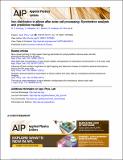Iron distribution in silicon after solar cell processing: Synchrotron analysis and predictive modeling
Author(s)
Fenning, David P.; Hofstetter, Jasmin; Bertoni, Mariana I.; Hudelson, S.; Rinio, M.; Lelievre, J. F.; Lai, Barry; del Canizo, C.; Buonassisi, Tonio; ... Show more Show less
DownloadBuonassisi_Iron distribution.pdf (639.6Kb)
OPEN_ACCESS_POLICY
Open Access Policy
Creative Commons Attribution-Noncommercial-Share Alike
Metadata
Show full item recordAbstract
The evolution during silicon solar cell processing of performance-limiting iron impurities is investigated with synchrotron-based x-ray fluorescence microscopy. We find that during industrial phosphorus diffusion, bulk precipitate dissolution is incomplete in wafers with high metal content, specifically ingot border material. Postdiffusion low-temperature annealing is not found to alter appreciably the size or spatial distribution of FeSi[subscript 2] precipitates, although cell efficiency improves due to a decrease in iron interstitial concentration. Gettering simulations successfully model experiment results and suggest the efficacy of high- and low-temperature processing to reduce both precipitated and interstitial iron concentrations, respectively.
Date issued
2011-04Department
Massachusetts Institute of Technology. Department of Mechanical EngineeringJournal
Applied Physics Letters
Publisher
American Institute of Physics (AIP)
Citation
Fenning, D. P. et al. “Iron Distribution in Silicon After Solar Cell Processing: Synchrotron Analysis and Predictive Modeling.” Applied Physics Letters 98.16 (2011): 162103. ©2011 American Institute of Physics
Version: Author's final manuscript
ISSN
0003-6951
1077-3118